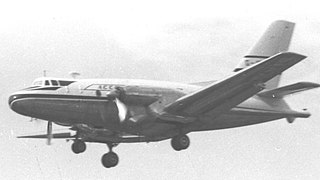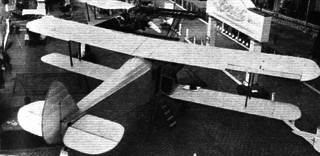Related Research Articles

The Handley Page HP.81 Hermes was a British civilian airliner built by Handley Page in the 1940s and 1950s. Closely related to Handley Page's Hastings military transport, the Hermes was a low-wing monoplane powered by four piston engines. Twenty-nine were built, serving briefly with BOAC in the early 1950s and later with several charter airlines.

The H.P. 75 Manx was a British experimental aircraft designed by Handley Page that flew test flights in the early 1940s. It was notable for its unconventional design characteristics, being a twin-engine tailless design of pusher configuration.

The Airspeed AS.6 Envoy was a British light, twin-engined transport aircraft designed and built by Airspeed Ltd. in the 1930s at Portsmouth Aerodrome, Hampshire.

The Aviation Traders ATL-90 Accountant was a 1950s British twin-engined 28-passenger turboprop airliner built at Southend Airport England by Aviation Traders, a member of the airline and aircraft engineering group controlled by Freddie Laker.

The Airco DH.10 Amiens was a British twin-engined medium bomber designed and built towards the end of the First World War. It served briefly postwar with the RAF.
The Arpin A-1 was a two-seat low-wing monoplane which was powered by a single radial engine in pusher configuration, mounted behind the cabin between twin booms that carried the tail. An unconventional fixed tricycle undercarriage was fitted. Only one was built.

The Luton Buzzard was a 1930s British single-seat, open cockpit ultralight aircraft built by Luton Aircraft Limited.

The Supermarine Sea Lion II was a British racing flying boat designed and built by the Supermarine Aviation Works for the 1922 Schneider Trophy at Naples, Italy which it went on to win. The earlier racing flying boat for the 1919 Schneider Trophy the Sea Lion I was a different design.

The Supermarine Sea Lion I was a British racing flying boat designed and built by the Supermarine Aviation Works for the 1919 Schneider Trophy at Bournemouth, England. The later racing flying boat for the 1922 Schneider Trophy the Sea Lion II was a different design.

The Supermarine Sea Eagle was a British, passenger–carrying, amphibious flying boat. It was designed and built by the Supermarine Aviation Works for its subsidiary, the British Marine Air Navigation Co Ltd, to be used on their cross-channel route between Southampton, the Channel Islands and France.

The B.A.C. Drone was a British ultralight single-seat aircraft of the 1930s.
The de Havilland T.K.5 was an unflown 1930s British single-seat canard research aircraft, designed and built by students of the de Havilland Technical School.

The Bristol Type 110A was a single-engine biplane for charter work, accommodating four passengers in comfort. Designed by Frank Barnwell and built at Filton Aerodrome by the Bristol Aeroplane Company. No orders were obtained and only one aircraft was built.

The Dart Kitten was a British-built ultra-light aircraft of the 1930s.

The Gadfly HDW.1 is a 1960s British two-seat cabin autogyro.

The Dart Pup was a British single-seat ultralight monoplane designed and built by Zander and Weyl at Dunstable, Bedfordshire.
The Wren Goldcrest was a British single-seat ultra-light low-wing monoplane designed by R.G. Carr and built by the Wren Aircraft Company at Kirklington near Carlisle in 1946.
The Fane F.1/40 was a 1940s British Air Observation Post aircraft design by Captain Gerald Fane's Fane Aircraft Company.

The Wallis WA-116 Agile is a British autogyro developed in the early 1960s by former Royal Air Force Wing Commander Ken Wallis. The aircraft was produced in a number of variants, one of which, nicknamed Little Nellie, was flown in the 1967 James Bond film You Only Live Twice.
The Henderson H.S.F.1 was a British six-seat low-wing monoplane designed by J. Bewsher and built by the Henderson School of Flying. Only one aircraft was built and it was scrapped in 1930 following the death of the owner George Lockhart Piercy Henderson.
References
Notes
- 1 2 3 4 5 Jackson 1973, p. 297
- ↑ "UK Civil Aviation Authority record for G-AELZ" (PDF). Archived from the original (PDF) on 6 June 2011. Retrieved 20 June 2009.
Bibliography
- Jackson, A.J. (1973). British Civil Aircraft since 1919 Volume 1. London: Putnam. ISBN 0-370-10006-9.